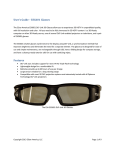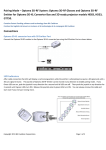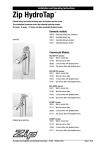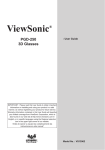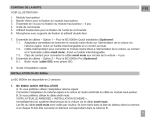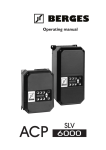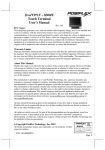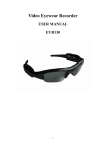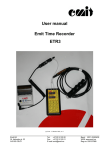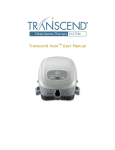Download User`s Manual - EStar America
Transcript
BC6000 3D Glasses Manual Note: there is a more detailed ESG6100 manual that better describes the features, connection, setup, and operation of the BC6000 LCD Shutter Glasses. The BC6000 LCD Shutter Glasses function with the BC100 3D Emitter and your 3D-Ready TV to provide the ultimate in 3D stereoscopic viewing. This document describes the features, connection, setup, and operation of the BC6000 LCD Shutter Glasses. Features RF synchronization for uninterruptable 3D glasses performance 50 to 240 Hz capable for today’s and future 3D TVs High contrast ratio, high uniformity and fast response time for excellent 3D experience Rechargeable battery provides up to 15 hours 3D viewing per charge Battery charge indicator lets you know remaining operating time Auto Upgrade ensures continued proper operation Charging Connector Indicator Light Power Button Copyright 2013 EStar America, LLC Page 1 of 9 Using the BC6000 3D Glasses Battery Charging To charge the BC6000, use the included USB-Power cable with the custom. The custom connector of the cable attaches to the DC connector on the top of the left earpiece of the glasses (see photo to the right). The red LED will turn on while battery is being charged. When the battery is fully charged, the red LED will turn off. The other end of the cable may be attached to any USB A-type port, such as a port on a USB hub, a computer, or the back of a TV. If attached to a computer, the BC6000 will use the computer only to receive power; the glasses will not appear as a device visible to Windows, Mac or other operating systems. The USB cable may also be attached to a USB charger or a phone charger with the identical connector. The BC6000 will charge in less than three hours, and can be operated while charging. The BC6000 battery is designed to operate up to 15 hours on a full charge. The glasses will consume more power as needed to maintain ultra-high reliability, meaning battery life is a function of many factors, including how much interference from 2.4 GHz devices like wireless routers must be compensated. Under the most adverse conditions, your glasses should operate flawlessly while battery life is being reduced (examples of “most adverse conditions” include trade shows or placing the glasses on a 2.4 GHz router performing continuous full-rate blasting on an interfering channel). Power Button and LED Indicator Function The inside left earpiece of the frames contains both the power button and the red/blue LED Indicator Light. Copyright 2013 EStar America, LLC Page 2 of 9 Power On and Battery Charge Indicator Press and hold the button until the blue LED comes on, then release the button. The blue LED will then blink in a pattern that indicates battery charge state. In general, the shorter and slower the LED blinks the more charged, and less in need of charge, the glasses are. Blink activity after power-on blink Battery Charge State Three long blinks after initial power on LED blink Battery is 50% or more charged, about 7 hours remaining. Six medium blinks after initial power on LED blink Battery is 10% or more charged, about 1 movie remaining. Twelve fast blinks after initial power on LED blink Battery charge is less than 10% or less, risk of glasses needing to be wired to charger before end of a long movie or double feature Power on indicator never occurs Battery is so discharged that glasses need to be charged before further operation If the glasses are powered off but charging, the LED will display a red LED while charging and turn off the red LED when fully charged. Powering Off Press and hold the button for between five to ten seconds; the LED will turn off and glasses will power off. Auto Power Off If the glasses do not detect an emitter, the blue LED will blink on and off once per second for five minutes and the BC6000 3D Glasses will auto power off. If the emitter is activated (the emitter is only active when then TV is in 3D mode) before the five minute period expires, the glasses will stop blinking and remain on. If the glasses auto power off, the power on button press is required to turn them back on, and the local invert polarity will be reset. Copyright 2013 EStar America, LLC Page 3 of 9 Pairing to an emitter With the device off, press and hold the power button. After 1-2 seconds the red LED will come on. Do not release the button after the red LED comes on, keep holding down the button. After about 10 seconds of the LED on solid the LED will start to pulse with the same “heartbeat” pattern used by the emitter in pairing mode. (When you see the heartbeat pattern, you must release the button within 20 seconds or the device will go into Restore Factory Defaults mode.) The glasses will stay in pairing mode until they successfully pair with an emitter, or until one minute expires. While in pairing mode, the LED will display the “heartbeat” pattern. If the glasses find an emitter in pairing mode, then the glasses will pair with the emitter and resume normal operation as described in Power On and Battery Charge Indicator. If an emitter is not found in pairing mode, the glasses will not operate but will continue to display the “heartbeat” pattern until the emitter is placed into pairing mode, at which point the glasses will pair and begin normal operating mode immediately. If the emitter is not placed in pairing mode, the glasses will stay in pairing mode for one minute and then will power down. Paired and unpaired glasses Out of the box, the glasses are unpaired. The glasses will begin operating with the first active emitter they recognize. (An emitter is active when it is on and receives a 3D signal from a TV or PC.) Unpaired glasses will continue to operate only with the same emitter they started operating with until they are powered down. If unpaired glasses are being used with an emitter that gets turned off, the glasses will auto power down, even if a different emitter is on or is turned on. Unpaired glasses will look for the emitter found during the last use. If the previously found emitter is not active, the glasses will start operating with the next emitter found. Unpaired glasses are convenient if you plan on taking your glasses to your friend’s house. Simply power down your glasses and take them to your friend’s house. When you power your glasses back up, the glasses will wait one second for your emitter and then start using your friend’s emitter. The process is reversed when you bring your glasses home. Paired glasses will not use the signal from your friend’s emitter. Once paired, BC6000 glasses will only recognize and synchronize with the emitter the glasses are paired to. This is useful if there are multiple emitters within range and you want to be certain that a pair of glasses is always associated with the same emitter. To pair glasses with a new emitter, simply put the glasses back in pairing mode along with the new emitter. To put paired glasses back in unpaired mode, the glasses must be restored to factory defaults. Firmware Upgrade The firmware version on the BC6000 3D Glasses is designed to properly operate with the firmware on the BC100 3D Emitter. Firmware on the glasses is upgraded as required by the emitter. When the Copyright 2013 EStar America, LLC Page 4 of 9 emitter is upgraded, new glasses firmware is loaded on the emitter. When glasses are powered on and find the upgraded emitter, the emitter sends the new firmware to the glasses and they restart. This process takes several seconds to complete. The glasses LED will blink slowly while the new firmware is being received and written to memory. Once the upgrade is complete, the glasses will automatically restart. The firmware version can be restored to the factory installed version by restoring factory defaults. Restoring Factory Defaults Restoring a pair of glasses to factory defaults restores the factory default settings and firmware. This includes putting the glasses in the unpaired mode. Any firmware or other settings on the glasses will be reapplied by the BC100 3D Emitter upon restart of the BC6000 glasses. To restore a pair of glasses to factory defaults, start with the glasses turned off. Press and hold down the button The LED will go on solid after 1 second; keep holding down the button After about 10 more seconds the LED will start pulsing indicating that the glasses are ready to pair; keep holding down the button. After about 20 more seconds the LED will start blinking rapidly. Release the button now. The glasses will restore the factory default settings and firmware. This can take several seconds. After the process is complete, the glasses will resume normal operation. If you do not release the button within 20 seconds after the LED begins rapidly blinking, the glasses will power off. Copyright 2013 EStar America, LLC Page 5 of 9 Detailed Technical Specifications BC6000 Glasses Model Name / Part No Operating Frequencies Technology Radio Nosepiece Duty Cycle Operating Temperature Accessories Dimensions Weight Battery Range Storage Conditions Copyright 2013 EStar America, LLC EStar America ESG6000 Glasses Kit with BC6000 glasses 100/120/144Hz (50/60/72Hz per eye) Plus arbitrary frequencies from 50-240 Hz Bit Cauldron RF-3D technology IEEE 802.15.4-2003 Rubber Adjustable 0'C - 40'C Cleaning Cloth, Nose Piece, USB Charging cable 170 x 168 x 40 (mm) 39g Rechargeable Lithium Polymer - Up to 15 Hours use Up to 100m (Dependent on environment) ≤90% Humidity Page 6 of 9 PATENT STATEMENT Patent Pending. Contains Patent Pending software and technology from Bit Cauldron. Contient les logitiels de brevet en instance et la technologie de la compagnie Bit Cauldron. REGULATOR NOTICES Bit Cauldron Corporation FCC ID: A4GBC6000 FCC ID: A4GBC100 FCC COMPLIANCE THIS DEVICE COMPLIES WITH PART 15 OF THE FCC RULES. OPERATION IS SUBJECT TO THE FOLLOWING TWO CONDITIONS: (1) THIS DEVICE MAY NOT CAUSE HARMFUL INTERFERENCE, AND (2) THIS DEVICE MUST ACCEPT ANY INTERFERENCE RECEIVED, INCLUDING INTERFERENCE THAT MAY CAUSE UNDESIRED OPERATION. CAUTION: Changes or modifications to this unit not expressly approved by the party responsible for compliance could void the user's authority to operate the equipment. Note: This equipment has been tested and found to comply with the limits for a Class B digital device, pursuant to Part 15 of the FCC Rules. These limits are designed to provide reasonable protection against harmful interference in a residential installation. This equipment generates, uses and can radiate radio frequency energy and, if not installed and used in accordance with the instructions, may cause harmful interference to radio communications. However, there is no guarantee that interference will not occur in a particular installation. If this equipment does cause harmful interference to radio or television reception, which can be determined by turning the equipment off and on, the user is encouraged to try to correct the interference by one or more of the following measures: Reorient or relocate the receiving antenna • Increase the separation between the equipment and receiver • Connect the equipment into an outlet on a circuit different from that to which the receiver is connected • Consult the dealer or an experienced radio/TV technician for help CANADA COMPLIANCE Industry Canada: 9186A-60007003 Industry Canada: 9186A -01007003 ICES -003: Digital Apparatus: Spectrum Management and Telecommunications Policy; InterferenceCausing Equipment Standard. This Class B digital apparatus complies with Canadian ICES -003. Cet appareil numérique de la classe B est conforme à la norme NMB -003 du Canada. Copyright 2013 EStar America, LLC Page 7 of 9 WARNING - SAFETY INFORMATION & PRECAUTIONS FOR INDOOR USE ONLY. NOT FOR USE AS SUNGLASSES. THE 3D KIT CONTAINS ELECTRONIC DEVICES AND THE FOLLOWING PRECAUTIONS SHOULD BE FOLLOWED: Do not wear 3D glasses for any other activity except viewing 3D pictures. These glasses will degrade visual perception in normal situations and are only intended for 3D use. Do not attempt to use as sunglasses. Handle the lenses carefully, especially when cleaning; too much force can easily damage the glass. Do not drop any unit or flex the glasses. When cleaning, do not soak or immerse or over wet the glasses; these are electronic devices, and moisture can damage or impair their function. Do not use chemicals containing alcohol, solvents or surfactants or chemicals such as wax, benzene, thinner, lubricant or cleaners. These may result in discoloration or cracks on the product surface and cause the indication labels to peel from the product surface. Use only fluids and products designed for screen cleaning and use them in accordance with the manufacturer’s recommendations. IMPORTANT - REVIEW THE FOLLOWING WARNINGS REGARDING THE EFFECTS OF 3D VIEWING PRIOR TO ENGAGING IN 3D VIEWING AND ENSURE YOU UNDERSTAND THE PRECAUTIONS AND POTENTIAL IMPACTS THAT 3D VIEWING CAN HAVE ON YOU AND/OR YOUR CHILDREN. Parental supervision is required especially when children or teenagers view 3D images. You may wish to consult a physician before allowing young children to view 3D. 3D TV’S and other 3D display devices use high speed flashes of light to generate a 3D effect. The light flash effect may produce seizures or epileptic seizures in certain individuals in addition to the following o Some light patterns may cause viewers to experience an epileptic seizure or stroke upon exposure to certain flashing images or light patterns contained in certain 3D television pictures or 3D video games. You should consult a physician before viewing 3D material if you or any of your relatives has a history of epilepsy or strokes. o “Photosensitive epileptic seizures” (reaction to flashes of light) can be caused by an undiagnosed condition even when family members have no history of epilepsy. o If you experience any of the following symptoms immediately stop watching 3D pictures and consult physician or other medical specialist: altered vision; lightheadedness; dizziness; involuntary movement such as eye or muscle twitching; confusion; nausea; loss of awareness of your surroundings; convulsions; muscle cramps; and/or disorientation. Parents should monitor and discuss with their children the above Copyright 2013 EStar America, LLC Page 8 of 9 symptoms. Children and teenagers may be more susceptible than adults to experiencing these symptoms. o Do not watch 3D picture when you feel incoherent, sleepy, tired or sick. Avoid watching 3D pictures for long periods of time. Take regular breaks, especially during long periods of 3D viewing. Watching TV while wearing 3D glasses for an extended period of time may cause headache, fatigue or dizziness. Remove the glasses and stop watching TV immediately if you experience this. Some 3D pictures may startle viewers. Due to the immersive nature of 3D viewing some scenes may cause viewers to reach out or react suddenly, to avoid these possibly dangerous reactions the pregnant, young children, elderly, epileptic and those suffering from serious physical conditions are advised to avoid watching 3D pictures. You should not watch 3D pictures if you are under the influence of alcohol, suffer from sleep deprivation or are in poor physical condition. 3D viewing is designed to be immersive. 3D glasses are designed to be worn only in a safe environment. If you are startled or misconstrue the 3D image as real, you may move in surprise, contact a nearby object or person and break nearby objects or injure yourself or others. Do not use the 3D glasses for any purpose other than the purpose it was designed for. Wearing the 3D glasses for any other purpose (as general spectacles, sunglasses, protective goggles, etc.) may physically harm you or weaken your eyesight Some lights, such as compact florescent, florescent, and LED lighting systems, may flicker at rates that are not perceivable to the naked eye but perceivable when wearing 3D glasses. Some lights that are particularly bright may also appear to flicker when observed with 3D glasses. DO NOT look directly into bright lights whether or not you are wearing 3D glasses. If you observe lights that flicker while wearing 3D glasses, discontinue use of the glasses immediately and turn off or move the lights so that there is no visible flicker while watching 3D. WARNING – FIRE AND INJURY DO NOT puncture, pierce, damage, destroy, or modify the battery contained in the glasses. Puncturing the battery may result in combustion or a fire, which could lead to severe burns and injury. DO NOT expose the battery to hot or cold temperature extremes. If there are any signs of damage to the battery, discontinue use of the glasses immediately. Copyright 2013 EStar America, LLC Page 9 of 9











